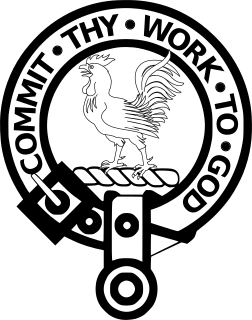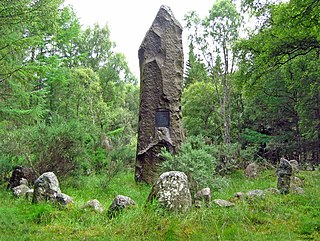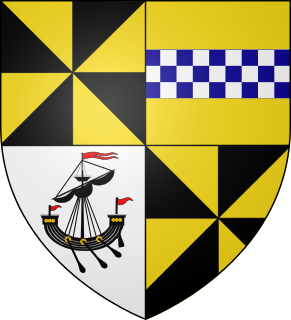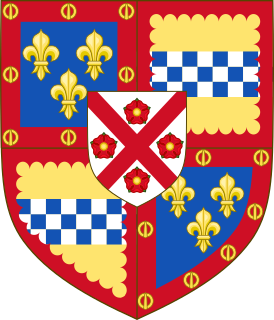
Longformacus House is a mansion near the village of Longformacus, Scottish Borders, Scotland. [1]

Longformacus House is a mansion near the village of Longformacus, Scottish Borders, Scotland. [1]
The estate was once owned by the Earls of Moray and then the Earls of Dunbar before passing to the Sinclair family. A castle may have existed at the site prior to the current mansion house. [2]
Robert Sinclair of Longformacus built the current mansion house in the early 18th century. A plaque shows the inscription "Adam delin" by the Scottish architect William Adam.

Dunbeath Castle is located on the east coast of Caithness, 2 kilometres (1.2 mi) south of Dunbeath, in northern Scotland. Although a castle has stood here since the 15th century, the present building is of mainly 17th-century origin, with 19th-century extensions. The castle is a Category A listed building and the grounds are included in the Inventory of Gardens and Designed Landscapes in Scotland.

Clan Gordon, also known as the House of Gordon, is a Scottish clan. The chief of the clan is the powerful Earl of Huntly, and now also the Marquess of Huntly. During the Wars of Scottish Independence in the 13th century, the Gordons supported William Wallace in the cause of independence. In the 15th century, the chiefship of the clan passed to an heiress, who married into the Seton family and her male descendants assumed the surname Gordon and continued as chiefs of the clan. The Gordons assisted in defeating the rebellion of the Earl of Douglas also in the 15th century. In the 16th century, the Gordons as Catholics feuded with their Protestant neighbors the Clan Forbes and also defeated at the Battle of Glenlivet, the Protestant Earl of Argyll. During the Wars of the Three Kingdoms of the 17th century, the Gordons supported the Royalist cause. During the Jacobite rising of 1715 the Clan Gordon was Jacobite. During the Jacobite rising of 1745, their chief, then the Duke of Gordon, pledged his support to the British-Hanoverian Government, but his clan remained Jacobite.

Clan Sutherland is a Highland Scottish clan whose traditional territory is the shire of Sutherland in the far north of Scotland. The chief of the clan was also the powerful Earl of Sutherland, however in the early 16th century this title passed through marriage to a younger son of the chief of Clan Gordon. The current chief is Alistair Sutherland who holds the title Earl of Sutherland.

Clan Sinclair is a Highland Scottish clan who held lands in Caithness, the Orkney Islands, and the Lothians. The chiefs of the clan were the Barons of Roslin and later the Earls of Orkney and Earls of Caithness. The Sinclairs are believed to have come from Normandy to England during the Norman conquest of England, before arriving in Scotland in the 11th century. The Sinclairs supported the Scottish Crown during the Scottish–Norwegian War and the Wars of Scottish Independence. The chiefs were originally Barons of Roslin, Midlothian and William Sinclair, 1st Earl of Caithness and Baron of Roslin founded the famous Rosslyn Chapel in the 15th century. He split the family lands, disinheriting his eldest son from his first marriage, William, who inherited the title of Lord Sinclair, instead giving the lands of Caithness to the second son from his second marriage, William Sinclair, 2nd Earl of Caithness, in 1476, and the lands at Roslin to his eldest son from his second marriage, Sir Oliver Sinclair. In the 16th century the Sinclairs fought against England during the Anglo-Scottish Wars and also feuded with their neighbors the Clan Sutherland. During the Jacobite rising of 1715 the Sinclairs supported the Jacobite cause, but during the Jacobite rising of 1745, while the clan largely had Jacobite sympathies, their chief, the Earl of Caithness, supported the British-Hanoverian Government. The current chief is Malcolm Sinclair, 20th Earl of Caithness.

Comlongon Castle is a tower house dating from the later 15th century or early 16th century. It is located 1 kilometre (0.62 mi) west of the village of Clarencefield, and 10 kilometres (6.2 mi) south-east of Dumfries, in south west Scotland. The original tower has been extended by the addition of a baronial style mansion, completed around 1900. Originally built by the Murrays of Cockpool, it remained in the Murray family until 1984. It was subsequently restored, having been vacant for some time, and the castle and mansion are now a hotel. As of 15 April 2019, the business side of Comlongon Castle has gone into Administration, consequently all weddings due and accommodation booked for after this date were cancelled, leaving the future of the castle uncertain.
The personal name Duncan can be found in Scotland’s oldest records in its Gaelic form Dunchad/Donchadh/Donachie/Donnchadh and other spelling variants.

Penkill Castle is a 16th-century castle with later additions. It is around 1⁄2 mile south of Old Dailly, northeast of Girvan in south Ayrshire, Scotland.

Milntown Castle was an early 16th-century castle which was situated near Milton, in Easter Ross, in the Scottish Highlands.

The Battle of Corrichie, also known as the Battle of Corrichy was a battle fought near Meikle Tap, near Aberdeen, Scotland, on 28 October 1562. It was fought between the forces of George Gordon, 4th Earl of Huntly, chief of Clan Gordon, against the forces of Mary, Queen of Scots, under James Stewart, 1st Earl of Moray.

The Battle of Altimarlach was a Scottish clan battle that took place on 13 July 1680, near Wick, Caithness, Scotland. It was fought in a dispute between Sir John Campbell of Glenorchy and George Sinclair of Keiss over who had the right to the title and lands of the Earl of Caithness. The battle was fought between men of the Clan Campbell and Clan Sinclair. Campbell of Glenorchy won a decisive victory in the battle, but Sinclair of Keiss later turned to the law and was awarded the title of Earl of Caithness.

The Watch Water is a river in the Scottish Borders area of Scotland. It rises in the Lammermuir Hills, around 8 kilometres (5.0 mi) west of Longformacus, and flows generally eastward to its confluence with the Dye Water, around 700 metres (2,300 ft) west of Longformacus. The Dye Water flows into the Whiteadder Water, which in turn is a tributary of the River Tweed.

Cranshaws is a village on the B6355 road, near Duns, in the Scottish Borders area of Scotland, in the former Berwickshire.
Banff Castle is a ruined former royal castle near Banff, Aberdeenshire, Scotland.
Kirkwall Castle, also known as King's Castle, was located in Kirkwall, the main settlement in the Orkney Islands of Scotland. Built in the 14th century, it was deliberately destroyed in 1614. The last ruins were cleared in the 19th century. The castle was located around the corner of Broad Street and Castle Street in the centre of Kirkwall.
Killellan House was a mansion house at Conie Glen, Kintyre, Scotland. Gutted by fire, the house was demolished in the 1960s, however the entrance lodge and gateway remain. The Killellan estate was held by the MacEacharn family from the 15th century, until controlled by the Earl of Argyll, with the estate coming back the MacEachan family in the late 17th century.

Kinnaird Castle is a 15th-century castle near Brechin in Angus, Scotland. The castle has been home to the Carnegie family, the Earls of Southesk, for more than 600 years. It is a Category B listed building and the grounds are included in Inventory of Gardens and Designed Landscapes in Scotland.
Glenbervie House is a mansion house, which has incorporated parts of an earlier castle, located near Glenbervie, Kincardine and Mearns, Scotland.

Evelaw Tower is a ruined 16th century tower house, about 2.5 miles (4.0 km) north west of Westruther, Scottish Borders, Scotland, and about 1.5 miles (2.4 km) east of Wedderlie, south of Eve Law.
Lamberton Castle was a castle located at Lamberton, in Scottish Borders, Scotland.

Houston House is an 18th-century mansion, about 1 mile (1.6 km) north and east of Bridge of Weir, Renfrewshire, Scotland, north of the village of Houston.